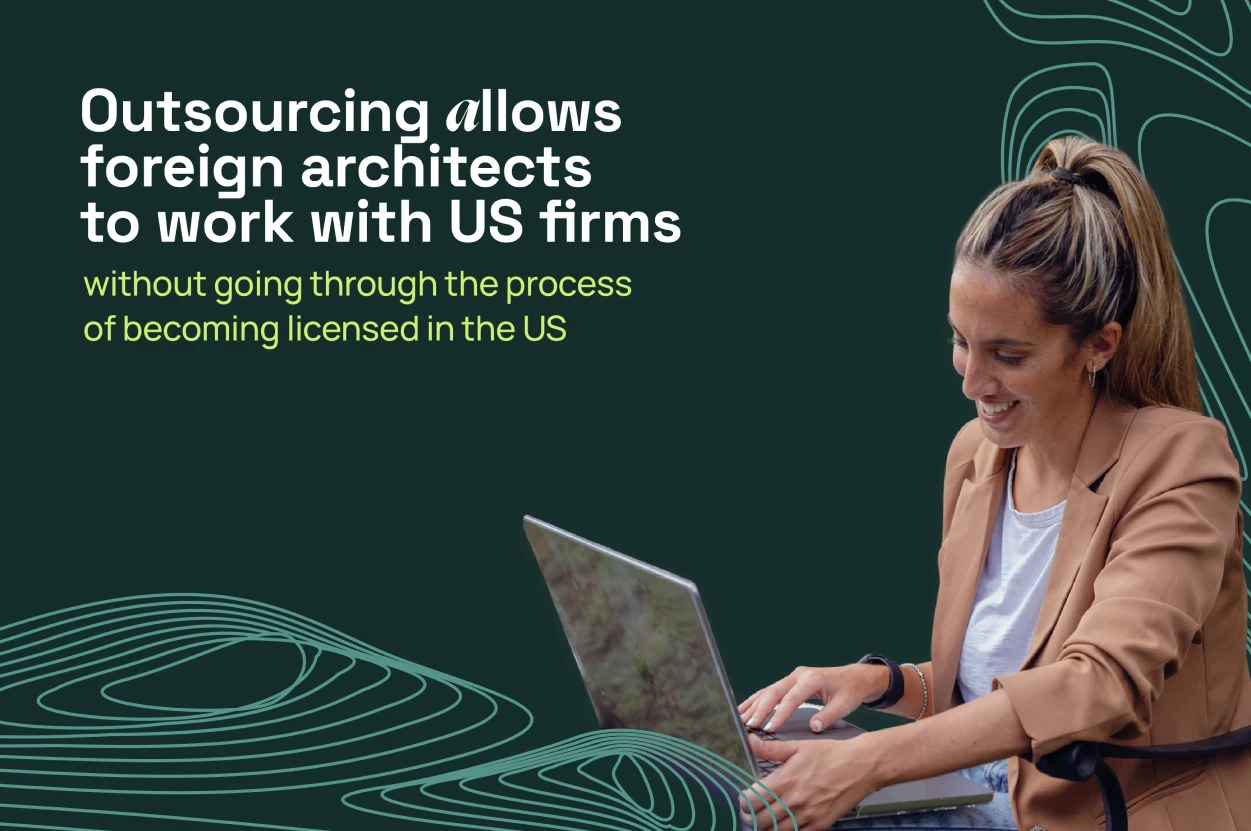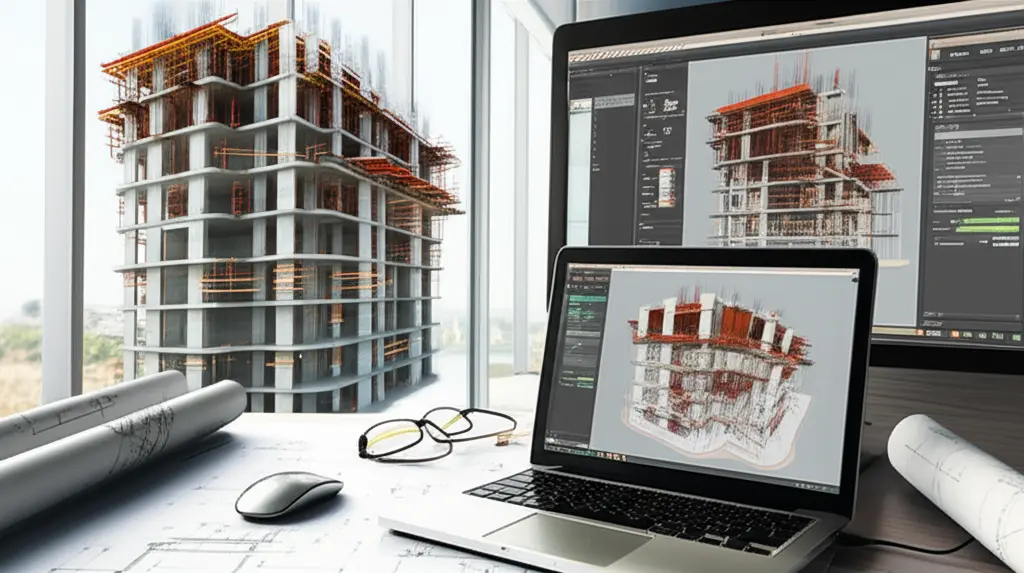Can foreign architects work in the US?

As globalization continues to shape the modern economy, businesses seek to tap into international talent pools to achieve their goals. For example, outsourcing has become popular in the architectural industry for companies looking to access high-quality talent and cut costs.
However, many businesses are still determining whether foreign architects can work in the United States. So, in this article, we’ll explore the requirements for foreign architects to work in the US and highlight the benefits of outsourcing architectural services.
And, of course, we’ll show you how to get outsourcing right for a change!
Can Foreign Architects Work in the US?
The short answer is yes, foreign architects can work in the US. However, there are specific requirements that they must meet first. The main requirement is to be licensed to practice architecture in the US. In order to become licensed, foreign architects must meet the same education, experience, and examination requirements as US architects.
To do so, they must meet certain requirements. According to the National Council of Architectural Registration Boards (NCARB), foreign architects who want to work in the US must first obtain a visa to work there legally.
Foreign architects can apply for several types of visas, including the H-1B visa, which is designed for professionals in specialty occupations, including architects.
To obtain an H-1B visa, foreign architects must have a degree from an accredited architecture program, a license to practice architecture in their home country, and a job offer from a US-based employer. The employer must also demonstrate that the foreign architect’s skills and experience are necessary for the company’s operations. Experience Requirements for Foreign Architects in the US.
In addition to the education requirements, foreign architects must also have experience working in architecture. The exact amount of experience required varies depending on the state where they plan to work. However, in general, foreign architects must have at least three years of experience working under the supervision of a licensed architect.
Additional Requirements to Consider
Some additional points to consider include:
Licensing Requirements
Besides obtaining a work visa, foreign architects must meet the licensing requirements of the state they intend to work in. These requirements can vary by state and may include passing the Architect Registration Examination (ARE) and completing a certain amount of work experience under a licensed architect.
Professional Organizations
Joining professional organizations such as the American Institute of Architects (AIA) can help foreign architects network and find job opportunities in the US. These organizations also provide resources for continuing education and professional development.
Cultural Differences
Foreign architects may encounter cultural differences when working in the US, such as differences in building codes, design standards, and construction methods. Foreign architects must familiarize themselves with these differences and adjust their approach accordingly.
Language barriers can also be a challenge for foreign architects working in the US. They must be proficient in English to communicate effectively with clients, contractors, and other stakeholders.
Benefits of Outsourcing
Outsourcing architectural services to companies like WorldTeams can provide many benefits, including access to a global talent pool of skilled architects, cost savings, and streamlined project management. But more on that later!

Architects from Around the World
For architects from different countries in the globe, becoming licensed in the US can be challenging. This is because the education and experience requirements may differ from those in the US. In addition, there may be language barriers and cultural differences that can make the process more difficult.
Benefits of Hiring Outsourced Global Architects
Outsourcing architectural services offers many benefits for businesses looking to access high-quality talent and reduce costs. Here are some of the advantages of working with architects based in different countries:
Cost Savings
Outsourcing architectural services can save companies significant money. The cost of living and labor is lower in many countries, meaning businesses can access top-quality talent at a lower price.
Access to Top Talent
Several countries around the world are home to many highly skilled architects who have received top-tier training and have years of experience working on complex projects. By outsourcing architectural services to worldwide, businesses can access this talent pool and benefit from their expertise.
Language and Cultural Compatibility
Working with architects from different backgrounds and countries can benefit companies that do business in Spanish or Portuguese-speaking countries. These architects are fluent in Spanish and Portuguese, and understand the cultural nuances of business in these countries, which can help companies to establish strong relationships with clients and partners.
Flexibility and Scalability
Outsourcing architectural services makes businesses more flexible and scalable. Companies can quickly increase or decrease their outsourcing needs based on their business requirements, which can be more difficult with in-house teams.
Hire Outsourced Architects from WorldTeams
If you’re looking to access top-quality architectural talent from all around the world, consider working with WorldTeams. This outsourcing company specializes in providing businesses with skilled architects worldwide.
WorldTeams offers highly skilled architects with years of experience working on complex projects and who speak English perfectly. Contact WorldTeams today to learn more about our architectural outsourcing services, and we can help your business succeed.
Remote Architects and Architect Outsourcing
There are still opportunities for foreign architects interested in working with US firms but want to avoid going through the process of becoming licensed in the US. Many US firms work with remote architects or outsource their work to architects in other countries. This allows foreign architects to work with US firms without going through the process of becoming licensed in the US.
As we said, the best option for foreign architects to work in the US is to apply for an H-1B visa. This type of visa allows foreign professionals in specialty occupations, such as architects, to work in the US for up to three years, with the possibility of an extension for another three years. The H-1B visa requires sponsorship from a US employer, who must also demonstrate that the foreign architect has the qualifications and experience for the job.
It is worth noting that the H-1B visa program is subject to an annual cap, which means that a limited number of visas are available each year. As a result, the competition for H-1B visas is often high, and the application process can be complex and time-consuming. In addition, there have been recent changes in the administration of the H-1B visa program, including increased scrutiny and longer processing times.
Another option for foreign architects to work in the US is through the L-1 visa program, which allows multinational companies to transfer employees from foreign offices to US offices.
This visa is available to foreign architects who a multinational architecture firm has employed for at least one year before their transfer to the US. The L-1 visa allows for a maximum stay of up to three years, with the possibility of extension for up to seven years.
Remote work is also becoming an increasingly popular option for architects, as it allows them to work for clients and firms anywhere in the world without having to relocate. Remote architects can work as independent contractors, freelancers, or employees of architecture firms that offer remote work options. This can be an excellent option for foreign architects who want to work in the US but are unable or cannot relocate.

Summing Up
In conclusion, foreign architects can work in the US through various avenues, including obtaining an architecture license, applying for visas such as the H-1B or L-1, working remotely, or partnering with outsourcing companies like WorldTeams.
Each option has its advantages and challenges, and it is essential for foreign architects to carefully consider their goals and priorities before deciding on a path forward.
Regardless, the demand for skilled architects in the US is ever-increasing. Foreign architects have many opportunities to contribute their expertise and creativity to the US architecture industry.
Hit us up for a free consultation if you’re looking to scale your companies, and work with the top 3% of global architectural talents!









